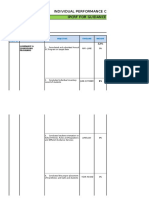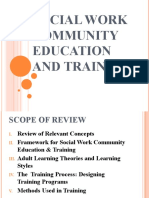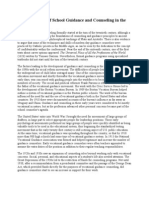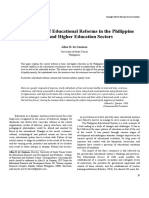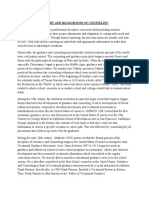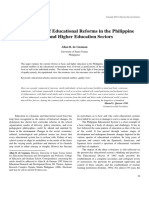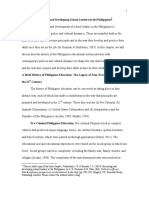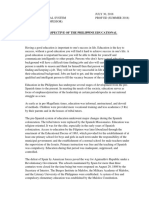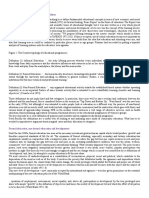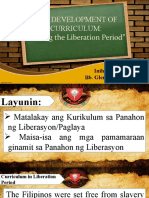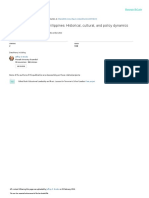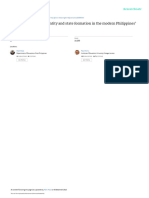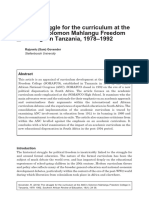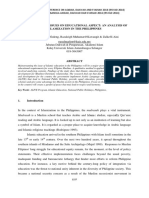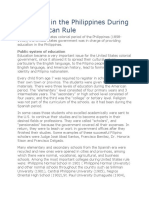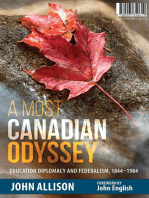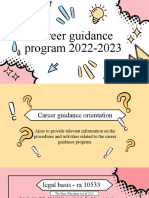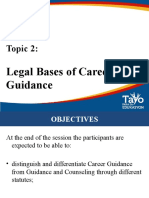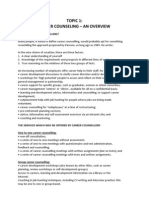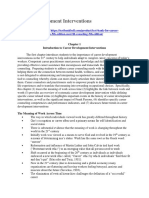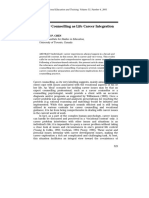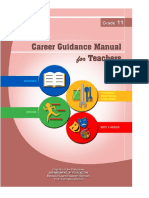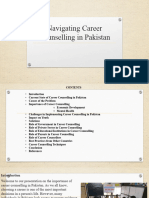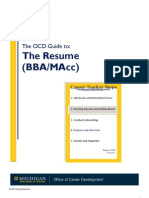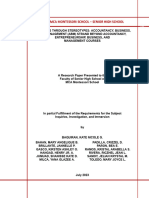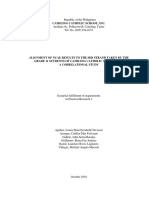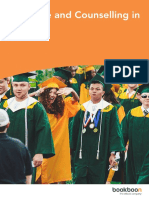Professional Documents
Culture Documents
Family Ties and Peso Signs: Challenges For Career Counseling in The Philippines
Family Ties and Peso Signs: Challenges For Career Counseling in The Philippines
Uploaded by
Freddie Jr TanlawanOriginal Description:
Original Title
Copyright
Available Formats
Share this document
Did you find this document useful?
Is this content inappropriate?
Report this DocumentCopyright:
Available Formats
Family Ties and Peso Signs: Challenges For Career Counseling in The Philippines
Family Ties and Peso Signs: Challenges For Career Counseling in The Philippines
Uploaded by
Freddie Jr TanlawanCopyright:
Available Formats
Family Ties and Peso Signs:
Challenges for Career Counseling
in the Philippines
Rose Marie Salazar-Clemena
The article's Ist section provides an overview of the historical development of
career counseling in the Philippines from an economic-political perspective.
The 2nd section raises current challenges and concerns, highlighting the need for
a career counseling model that would address, among other things, Filipinos'
valued characteristics of close family ties and desire for economic progress.
Like many other aspects of Filipino life, the development of psychology
and guidance in the Philippines bears heavy traces ofU.S. influence. This
is probably the result of years under U.S. colonial rule, with English as the
medium of instruction facilitating the "Americanization" of the Filipinos.
The development ofcareer counseling, in particular, just like its U.S. coun-
terpart, is interwoven with the growth of psychology and the guidance
movement in the schools.
Historical Perspective
Career counseling in the Philippines can best be understood from an
economic-political perspective (Pope, 2000) and in light of Filipino cul-
tural traditions. Its evolution can be divided into five periods, roughly
corresponding to stages in the nation's political history.
First Period (1913-1934): Occupational Information
The first reference to vocational guidance in the Philippines can be found
in the 1913 report of the Bureau of Public Schools, which stressed the
need to collect information about employment opportunities in different
industries. From 1926 to 1930, teachers made available to pupils numer-
ous materials for occupational and educational guidance. In 1933, the
Rotary Club of Manila helped finance the publication of reference mate-
rials on various trades and professions (Abiva, 1991). Limited and infor-
mal guidance services were then being offered by only two colleges in
Manila (starting in the 1920s). Toward the end of this period (1932), the
University of the Philippines established a psychological clinic-the first
in the country (Ros, 1965).
Rose Marie Salazar-Clemeii« is a professor in the Counselor Education Depart-
ment at De La Salle University, Manila, Philippines. The author thanks Allan B.
1. Bernardo, Thomas Kallookaran, Joseftna 0. Santamaria, and Roberto G. Clemena
for their assistance. Correspondence regarding this article should be sent to Rose
Marie Salazar-Clemena, Counselor Education Department, De La Salle Univer-
sity,2401 TaftAvenue, Manila 1004, Philippines(e-mail: cedrmc@mail.dlsu.edu.ph).
246 The Career Development Quarterly March 2002' Volume 50
The focus on occupational information at that time could be seen in the
context of the varied employment prospects brought about by the eco-
nomic climate created during the U.S. colonial period. The economic
depression in the 1930s further bolstered the need to disseminate such
information.
Second Period (1935-1945): Guidance and Counseling
Services in the Schools
The second period saw the growth of guidance and counseling services in
public and private high schools-first in Manila and later in the prov-
inces. Deans of boys and deans of girls were assigned to help students
with disciplinary, academic, vocational, and emotional problems (Salazar-
Clemefia,1993).
This growth of school guidance and counseling programs was not accom-
panied, however, by appropriate training of the designated counselors. It
was only in 1945, a year before the Philippines regained its independence,
that the first Guidance Institute was conducted by armypsychologists from
the United States (Ordonez, 1985).
This l O-year transition period before the Philippines became a fully
independent republic included the Japanese Occupation (1941-1945).
With some schools being closed for part of this time, guidance services
naturally were also suspended. Even when schools were allowed to re-
open, many students and teachers did not come back because of the
economic conditions (Laconico-Buenaventura, 1993-1994).
Third Period (1946-1969): Counselor Training and
Professional Organizations
The postwar period emphasized counselor training and ushered in the
birth of organized professional associations. Seminars were conducted
for teachers who had been assigned, without the requisite preparation,
guidance tasks. Resource persons for these seminars included visiting
UN and Fulbright professors (Ros, 1965). At approximately the same
time, teachers andschool officialswere being sent to the United States to
take courses in guidance and observe school guidance programs (Salazar-
Clemefia,1993).
Formal degree programs in counselor education began at the graduate
level in the mid-1950s. Later, guidance was introduced as a field of spe-
cialization at the undergraduate level as well. Ros (1965), analyzing the
program descriptions of 31 graduate schools offering a master's degree
in education (with a major in guidance), found that 68% of these pro-
grams included a course in Vocational Guidance.
The guidance movement in the schools gained further impetus when a
Joint Congressional Committee on Education mandated in 1951 that
guidance and counselingprograms should assist students with careerchoices,
personal difficulties, school and home tasks, job placement, and initial
work adjustment (Salazar-Clemefia, 1993).
Although the Guidance Association of the Philippines, the first formal
organization of Filipino counselors, had been established in 1945 as an
offshoot of the first Guidance Institute, and another organization, the
Philippine Association ofGuidance Counselors, had been formed in 1953,
it was the founding ofthe Philippine Guidance and Personnel Association
The Career Development Quarterly March 2002 • Volume 50 247
(PGPA; now known as the Philippine Guidance and Counseling Associa-
tion [PGCA]) in 1965 that spurred the improvement of standards of
guidance and personnel work (Salazar-Clernena, 1993).
The PGPA was born at a time when experts were observing an "imbalance
ofman-power training and man-power need" (Bernardino, 1965, pp. 3-4)
and "a great number ofunemployed with college degrees" (Limcaco, 1965,
p. 8). Counselors were, therefore, challenged "to prepare students in
careers that will give them satisfaction, financial security, and employment
after completing their studies" (Bernardino, 1965, p. 4).
FourthPeriod(197o-1986): Intensified CareerGuidanceEfforts
The fourth period was marked by increased attention to career guidance,
in general, and to career information and tests, in particular. The obser-
vation earlier mentioned by Bernardino (1965) was reiterated in the 1970
report of the Presidential Commission to Survey Philippine Education
(PCSPE) that found a mismatch between students' college courses and
the training required by the world ofwork (Santamaria, 1979). The PCSPE
further reported that most high school graduates applied for admission
into college degree programs, regardless of their qualifications or the job
opportunities that would be later available to them. This was perceived as
being a reflection of the high value Filipinos placed on a college educa-
tion; a college diploma was viewed as a means to achieve social and eco-
nomic mobility (Santamaria, 1979). Few high school students were seek-
ing entrance into the mechanical, electrical, chemical, agricultural, and
fisheries fields, where there was a high demand for human resources. On
the other hand, many of those who opted for professional degree pro-
grams did not have the requisite abilities.
The PCSPE report stimulated the growth spurt of career guidance in
the country. On the basis of its recommendations, the government initi-
ated the following steps: (a) the introduction ofweekly I-hour homeroom
guidance periods, with emphasis on career development, in all elemen-
tary and secondary schools; (b) the institution of the National College
Entrance Examination (NCEE) as a basis for students' admission into
professional degree programs in college; (c) the development and main-
tenance of "a responsive vocational guidance and testing system in aid of
human resources allocation" (Presidential Decree 1412, as cited in
Santamaria, 1979, p. 7) by the Bureau of Employment Services; and (d)
the delineation oftwo major thrusts by the National Manpower and Youth
Council (NMYC; now incorporated into the Technical Education and
Skills Development Authority): skills training and vocational guidance
for out-of-school youth (Santamaria, 1979).
The private sector also responded to the PCSPE-identified needs. De La
Salle University (DLSU, then known as De La Salle College) launched two
projects in cooperation with the NMYC and some private foundations and
industrial firms: one that aimed to develop career monographs and audiovi-
sualmaterials (Salazar, 1986) and another that sought to developa multiaptitude
test battery that waspatterned afterthe GeneralAptitude Test Battery (Salazar,
1977). The Rotary Club ofManila, on the other hand, again came into the
picture as a publisher ofcareer information books.
The emergence of a movement to explore indigenous psychological
concepts and methods inspired attempts to develop psychological tests
248 The Career Development Quarterly March 2002 • Volume 50
and other assessment instruments that were suitable for Filipinos. Many
such efforts came from thesis and dissertation writers, mainly in the form
ofdeveloping local norms, translating English texts to Filipino or making
adaptations using local situations and scenes (Almonte, as cited in
Evangelista, 1990). Continuing efforts on a larger scale, however, came
from the Center for Educational Measurement (CEM), which has pro-
duced, among others, the Philippine Aptitude Classification Test and the
Philippine Occupational Interest Survey (CEM, 1997-1998).
Many ofthese locally developed instruments (e.g., measures ofaptitude
and interest) were patterned after their Western counterparts, using what
is called the "apples to bananas" approach (i.e., changing foreign names
to local names). Others, however, particularly in the areas of personality
and values, resulted from attempts to "'indigenize from within'"
(Evangelista, 1990, p. 13), starting with the operationalization of con-
structs and theories within the cultural context.
This intensified focus on career guidance and counseling took place
alongside organized moves to provide specialized training for counselors
in this area. In 1973, the PGPA prepared a career education handbook
for use by teachers and counselors in helping students, now exposed to
a revised work-oriented curriculum, plan their careers. This career/
vocational guidance emphasis was further pursued in the PGPA annual
conventions ofl973 and 1974.
Formal training through graduate courses in career counseling was ini-
tiated, based partly on models derived from the United States 0. O.
Santamaria, personal communication, October 1999). By 1985, halfof
16 master's-level counselor education programs were offering Career
Counseling or Vocational and Adult Guidance as a major subject or as an
elective (Salazar, 1987).
Another landmark in the development ofcareer guidance and counsel-
ing during this period was the establishment in 1977 of the Philippine
Vocational Guidance Association (later renamed the Philippine Asso-
ciation for Career Guidance and Development [PHICGUIDE], and
now known as the Career Development Association of the Philippines
[CDAP]). The organization sought to professionalize the practice of
career guidance and counseling in the country. It also tried to involve
human resource development (HRD) practitioners from the government
and industrial sectors. In 1980, it hosted the 10th World Congress-the
first in Asia-of the International Association of Educational and
Vocational Guidance (IAEVG).
International linkages continued after this, with the Philippines again
playing host a year later to a conference on career counseling organized
by the Asian Women's Institute, a consortium of Asian women's Chris-
tian colleges. The assembly, funded by the AsiaFoundation and the United
Board for Christian Higher Education in Asia, brought together women
educators from Asia and the United States. Collaborative efforts eventu-
ally led to the formulation ofan Asian model of career services (Phailbus,
1985), discussed in the book Women and Workin Asia and its companion
volume Aspirations: A Career Planning Handbook for the New Asian
Woman (Quisumbing & Lazarus, 1985a, 1985b). The Asia Foundation
also supported the establishment of the Center for Women's Studies and
Development in Silliman University, Dumaguete City, in the Philippines.
The Career Development Quarterly March 2002 • Volume 50 249
In 1982, the Department of Education, Culture, and Sports launched
the Technical and Vocational Education Project in cooperation with De
La Salle University. The project established a Center for Counselor Training
in Career Counseling, which was tasked to train career counselors for
technician education institutes and to develop a Technician Careers In-
formation Handbook (Salazar, 1986).
All of these developments took place while the country was under the
Marcos dictatorship (and even after he ostensibly lifted martial law in
1981). The monopolies he established extracted billions from the Philip-
pine economy, leaving the country poorer in 1986, when he was ousted,
than when he first took office in 1965. In addition, tariff protection and
an overvalued peso hindered growth and depressed employment (Ar-
royo, 1998). A Higher Education and Labor Market Study (HELMS I;
Sanyal, Perfecto, & Arcelo, 1981) conducted during this period pointed
out the overqualification of many employees and the export of trained
human resources overseas.
Fifth Period (1987-Present): Expanded Career Counseling
Services
The restoration of democracy buoyed up hopes for economic progress.
Fifteen years since then, however, the problems of poverty, unemploy-
ment, underemployment, and rapid population growth remain. These
conditions have led to the rising number of Filipinos working overseas to
seekthe proverbial greener pastures.At the sametime, developmentsbrought
about by globalization and the information age have led the corporate
world toward reengineering, resulting in many workers being displaced or
made to opt for early retirement.
These conditions have contributed to the expansion of career counsel-
ing services outside the school setting. As part of their organizational
development and human resource development programs, an increasing
number ofcompanies now provide career counseling servicesto their per-
sonnel. In addition, the prospects of overseas employment have encour-
aged many individuals to establish private placement and career services
centers, emphasize psychological testing and job placement. Government-
run skills training centers also provide career guidance services through
information dissemination, client assessment, counseling, and placement/
self-employment assistance. Schools continue to offer career guidance
services (counseling, testing, and information), this time aided by online
career information sources.
Current Concerns and Challenges
Given this historical perspective and the present sociopolitical conditions
in the country, career counselors now face a number of concerns and
challenges.
Concerns
Surveys among guidance counselors conducted 17 years apart (Salazar-
Clerneria, 1992; Santamaria,1975) haverevealed that career-related problems
of Filipino students remain largely unchanged. These include concerns
that may be categorized as sociological (no choice, uncertain choice, or
250 The Career Development Quarterly March 2002 • Volume 50
unwise choice, based chiefly on sociocultural expectations), psychological
(lack ofinformation, low self-worth); and general (problems ofskill; Crites,
1969). The later sample added the following concerns: lack of interest in
anything, and lack of matching between interest, on the one hand and
academic performance and work opportunities, on the other hand.
Challenges
These concerns and other prevailing conditions pose several challenges
for career counseling in the Philippines today.
Family ties and peso signs. The matter ofchoosing a career in the Philip-
pine setting is clearly a family affair. Most studies on career choice (Suba,
in press) reveal the crucial role of parental influence in the career choices
of Filipino adolescents. This reflects the high value Filipinos place on
close family ties, to the point of making sacrifices for the family welfare
(Go, 1994). For the vast majority, who pin their desire for economic im-
provement (another valued characteristic; Church, 1986) on a son or
daughter's completion of a degree, this often means arriving at career
choices for their children, regardless of the factors considered by person-
environment fit theories. The primary consideration of many a parent be-
comes "What college education can we afford that can make you finish
quickly, get a job, and start helping with family finances?" In other words,
their concern is not finding guideposts in a career path, but peso signs that
would lead them out ofpoverty. In a country in which quality education is,
for the most part, inaccessible to the poor, this approach results in students
getting into low-quality schools or programs that will not give them a com-
petitive edge in the labor market. The options open to such people cannot
be too many, notwithstanding the continuing preference for white-collar
jobs. This situation raises a challenge for career counselors who work on
the Western-based assumption "that individuals are able to economically
afford choice" (Gysbers, Heppner, & Johnston, 1998, p. 34).
Employability. Studies done in different periods of career counseling in
the Philippines (e.g., Agana, 1982; Cunanan, 1968; Salazar-Clernena,
1992; Tritz, de Blanco, & Pagaduan, 1965) show common reasons for
the curricular choices ofcollege and high school students: interest in the
field, opportunity for employment, personal or family welfare, financial
returns, and influence of role models (mostly family members). Other
factors that emerged in more recent studies include prestige, admiration,
status, ability, influence of media (Osdeg, Salvilla, & Sinajon, as cited in
Salazar-Clernena, 1992), security, peer and family (other than parents)
influence, and opportunity to go abroad (Salazar-Clernefia, 1992).
Given the continuing mismatch between training and employment, the
employability of graduates who choose to enter fields that have a low
demand is another challenge. In dealing with it, career counselors will
have to take into account the family's values, their (mis)perceptions of
employment opportunities, and the importance they place on economic
factors in career decision making. This will probably mean helping fami-
lies see "peso signs" in roads that are vital to the country but where the
majority of students had previously feared to tread or where roadblocks
due to stereotyping had been set up.
Appropriateness ofcareercounseling models. As it was in the U. S., the term
vocationalguidance was used earlier in the history ofcareer counseling in
The Career Development Quarterly March 2002 • Volume 50 251
the Philippines. By 1972, vocation had been replaced for the most part by
the term career 0. O. Santamaria, personal communication, October
1999), viewed more broadly now to mean the course of one's life as
reflected in one's choices and decisions with regard to work, education
or training, and lifestyle (Santamaria, 1993).
Career development, vocational development, and occupational devel-
opment, on the other hand, are used interchangeably and refer to
a life-long process of developing/refining attitudes, beliefs and values, skills
and abilities, interests, personality traits or behaviors; discovering aptitudes;
and acquiring knowledge about the world of work so that a person can make
decisions at every stage of her [or his1 life and commit herself [or himself)
to implement them. (Santamaria, 1993, p. 18)
This concept seems to be based, for the most part, on Super's (1957) model.
Super's (1957) model was also the basis ofworks that focused on women
(e.g., Villarosa, 1987; Ybanez, 1985). Villarosa, however, likewise used
the career choice theories of Holland (1959) and Roe (1956) as well as
Lofquist and Dawis's (1969) Theory of Work Adjustment (TWA). The
TWA similarly formed the basis of Salazar's (1981) study on the satisfac-
tion and satisfactoriness ofcounselor training graduates, which provided
evidence for the cross-cultural validity of the model.
Three surveys (Villar, 1997) have shown that many Filipino counselors
are familiar with the Trait-and-Factor Theory (Williamson, 1950) but
use it to a moderate extent. It is, however, one of the most widely misun-
derstood and misused models; many counselors equate it with simple
advice giving (being "directive"). Furthermore, it seems that most prac-
titioners and even counselor educators are not aware of the evolution of
trait-and-factor counseling into person-environment correspondence/fit
counseling (Chartrand, Lofquist, & Dawis; Rounds & Tracey, as cited in
Swanson, 1996). There is, in fact, the misconception that the trait-and-
factor approach seems "to encourage the expectation that accurate infor-
mation about the individual ... can only be obtained by having him [or
her] take a battery of standardized tests" (Santamaria, 1975, p. 44). As
Brown (as cited in Swanson, 1996) stated, "Williamson never advocated
a test-and-tell approach or a simplified approach" (pp. 98-99).
Another model that is popular among Filipino counselors is Walz's Life/
Career Development System(Waiz & Benjamin, 1983). This can be probably
explained by their exposure to workshops on this topic organized by the
Philippine Association for Career Guidance and Development
(PHICGUIDE, 1988; Santamaria, 1979). This model is used in schools
as well as in companies, particularly in those undergoing reengineering
(Villar, 1998).
Studies on the effectiveness of career guidance/counseling programs have
been based on theories of Super, Tiedeman and O'Hara, Holland, Gellatt,
and others (Suba, in press). Suba's (1996/1997) study used the career coun-
selingmodelsofBrownand Brooks(1991) and McDanielsand Gysbers (1992).
The popularity of the aforementioned models among Filipino counselors
basically reflects the ease with which practitioners take to ideas and
approaches that are learned abroad or are brought in by foreign experts.
These approaches, however, seem to focus on individuals making choices
by themselves and for themselves. This is a basic tenet of Western psy-
252 The Career Development Quarterly March 2002 • Volume 50
chological theories. The Filipino concept of self, however, is rooted in
kapwa, "a recognition of ' shared identity'" (Enriquez, 1993-1994, p. 8),
a selfin relation to others (Salazar-Clernena, 1997). It may, therefore, be
necessary to create alternative paradigms that will factor in this core cul-
tural value. One option may be to develop a family career counseling ap-
proach that will highlight "family ties" and enable the family, as a system,
to consider from a broader perspective the "peso signs" and other factors
important in decision making. The significance ofthis family system orien-
tation has been recognized in career counseling literature (Benjamin, 1992).
Santamaria (1993) offered a five-stage model for career counseling in
the Philippines. Defined as "the process of helping a person understand
herself[or himself] and the situation, identify options, make choices from
among these options, and implement her [or his] decisions" (p. 19), career
counseling covers the following stages: self-expression, self-understanding,
decision, goal setting/action planning, and follow-up (Santamaria, 1993).
The model, suggested for use in both individual and group counseling, in
school and industrial settings, is "a composite or synthesis of a number of
approaches, particularly the behavioral and client-centered approaches"
(Santamaria, 1975, p. 41). Surveys have shown that the latter approach
is known and used by Filipino counselors to a great extent, the former
only to a moderate extent (Villar, 1997). The eclecticism in Santamaria's
model may appeal to many practitioners because the eclectic approach is,
in fact, a strategy reportedly used by counselors in the elementary, sec-
ondary, and collegiate levels ofeducation (Salazar-Clernena, 1993). The
model fails to point out, however, how the sociocultural context ofcareer
decision making will be made. This might be the reason that Santamaria
(1975) offered it as a starting point, with the invitation for counselors to
modify the suggested techniques when necessary.
Career developmentfocus. Despite the accepted view of career develop-
ment as a lifelong process that involves not only decisions about the world
of work but also other choices at every life stage, much of the research
and practice in the Philippines has focused on helping individuals take
steps toward a school-to-work transition. Thus, greater attention has
been given to high school students who are contemplating postsecondary
education with a view toward potential careers. Not much has been done
for other populations across the life span and in various circumstances,
such as out-of-school youth, child laborers, women, physically disabled
individuals, employed adults, unemployed adults, overseas workers, those
in midlife transitions, workers eligible to retire, and retirees. Neither has
there been much interest in career aspects other than work (e.g., way or
style of life, state of life, leisure activities). These gaps certainly deserve
to be filled in.
Research. Because the major career development theories "are based on
small samples of White, middle-class males" (Herr & Cramer, as cited in
Arbona, 1990, p. 301), there is a need for further research that can lead to
a better understanding of the career development of Filipinos and help
them make better career choices and life adjustments. Such studies and,
eventually, models and approaches must consider the nature of Filipinos'
career-related problems, factors influencing their decision making, and
change patterns in their career choice. Present data seem to suggest that
these will have to be explained not only psychologically but also economi-
The Career Development Quarterly March 2002 • Volume 50 253
cally (i.e., peso signs), and socioculturally (e.g., close family ties) as well.
Among the major extant theories, it seems that two models have the flex-
ibilityand adaptabilityto incorporate the economic, sociological,cultural, and
psychological career concerns of Filipinos: the person-environment fit ori-
entation (Swanson, 1996) and Super's stage theory (Fouad & Arbona, 1994).
An ongoing survey points to the extensive use by counseling practitio-
ners ofD.S.-made assessment tools (1. Coronel, personal communica-
tion, November 5, 1999). The cross-cultural validity ofsuch tests should
be evaluated on the basis of criteria suggested by Paniagua (as cited in
Gysbers et al., 1998). At the same time, there is a need to develop more
indigenous instruments to measure aspirations, interests, choice, motiva-
tion, success, satisfaction, maturity, and work values, among others, and
more materials for career guidance and counseling. Already, there are
locally developed instruments such as the Career Exploration Inventory
(Santamaria, 1980), the Sales Orientation Survey, and the Trait Survey
(Asian Psychological Services and Assessment Corporation, n.d.), and
the Filipino Work Values Inventory (Cervera, 1987). There are also
materials such as Women and Career Development: Focus on Life Roles
(Ybanez, 1985), a Photo Career Discovery Kit (Abiva, 1991), and a self-
help workbook (Barcelon, 1992), but these are not sufficient. As the
number of career alternatives in an era ofglobalization increases, there is
likewise a need to develop updated career information materials.
Cultural dil'ersity. Although some general Filipino characteristics have
been discussed in this article, it must be remembered that Filipinos are
not a homogeneous unit. Like other cultural groups, Filipinos are not
monolithic in their orientations in life. Their worldviews, which can be
describedashavingseveral elements--optimistic aswellasfatalistic; theocentric,
but also egocentric and other-centered; proactive and purposive; person-
centered and situation-centered; affectiveand cognitive; material, spiritual,
and transpersonal (Salazar-Clernena, 1993, 1997)-will certainly lead to
various career perspectives. The ultimate challenge, then, seems to be
the development of a culture-sensitive career counseling model that will
address this cultural diversity.
References
Abiva, T. G. (1991, July). CareerguidlJnceIJnd deTIelopment brelJkthroughs, glJinsIJnd pros-
pects. Paper presented at the PACERS-APECA-DLSU Conference-Workshop, Manila,
Philippines.
Agana, G. A. (1982). The influence of role models in career decision-mlJking in two commu-
nities. Unpublished master's thesis, University ofthe Philippines, Diliman, Quezon City.
Arbona, C. (1990). Career counseling research and Hispanics: A review of the literature.
The Counseling Psychologist, 18, 300-323.
Arroyo, D. M. (1998, December 21). Why is the Philippines sopoor? Retrieved January 8,
2001, from the World Wide Web: http://www.gslink.com/-go2net/why.htm
Asian Psychological Services and Assessment Corporation. (n.d.). [Brochure]. Manila,
Philippines: Author.
Barcelon, E. E. (1992). The deTIelopment of IJ self-help workbook on career pllJnningfor col-
lege grlJdulJting students. Unpublished master's thesis, De La Salle University, Manila,
Philippines.
Benjamin, B. A. (1992). Career counseling with couples. ]ournlJl of Counseling & Devel-
opment, 70, 544-549.
254 The Career Development Quarterly March 2002 • Volume 50
Bernardino, V. (1965). Welcome address. The Guidance and Personneljournal, 1(2), 3-4.
Brown, D., & Brooks, L. (1991). Career counseling techniques. Boston: Allyn & Bacon.
Center for Educational Measurement. (1997-1998). Annual report. Makati City,
Philippines: Author.
Cervera, V. M. (1987). Filipino Work Values Scale manual. Quezon City, Philippines:
Author.
Church, A. T. (1986). Personality research: A review of research and writings. Manila,
Philippines: De La Salle University Press.
Crites, 1. O. (1969). Vocational psychology. New York: McGraw-HilI.
Cunanan, L. G. (1968). Curricular choices of third year students in the Manila public
high schools, 1966-1967. The Guidance and Personnel journal, 3( I), 60-63.
Enriquez, V. G. (1993-1994). Indigenous psychology: From traditional indigenous
concepts to modern psychological practice. De La Salle University Dialogue, 27(2),
1-19.
Evangelista, S. P. (1990). The development and validation of a security/insecurity
inventory for Filipino college students. Philippine journal of Counseling Psychology,
2, 13-22.
Fouad, N. A., & Arbona, C. (1994). Careers in a cultural context. The Career Develop-
ment Quarterly, 43, 96-104.
Go, S. P. (1994). The Filipino youth: Their views and values on marriage and family
life. Kaya Tao, Behavioral SciencesDepartment journal, De La Salle University, 13,
1-27.
Gysbers, N. C., Heppner, M. J., & Johnston, J. A. (1998). Career counseling: Process,
issues, and techniques. Boston: Allyn & Bacon.
Holland, 1. L. (1959). A theory of vocational choice. journal ofCounseling Psychology,
6, 35-45.
Laconico-Buenaventura, C. (1993-1994). The Japanese role in re-awakening the Fili-
pino native soul. Anuaryo/Annales, 12,25-57.
Lirncaco, E. R. (1965). Inaugural address. The Guidance and Personnel journa~ 1(2),5-11.
Lofquist, L. H., & Dawis, R. V. (1969). Adjustment to work. New York: Appleton-
Century-Crofts.
McDaniels, C., & Gysbers, N. C. (1992). Counseling for career development: Theories,
resources, and practice. San Francisco: Iossey-Bass,
Ordonez, M. A. (1985). Guidance in the Philippine setting. Quezon City, Philippines:
Vermar Printing.
Phailbus, M. (1985). Preface. In L. R. Quisumbing & B. B. Lazarus (Eds.), Women &
work in Asia: A callfor action (pp. ix-x). Manila, Philippines: Commission on Women
and Work, Asian Women's Institute.
Philippine Association for Career Guidance and Development. (1988, March 3-4).
The PHICGUIDE through the years. PHICGUIDE 10th Anniversary Convention-
Workshop Souvenir Program.
Pope, M. (2000). A brief history of career counseling in the United States. The Career
Development Quarterly, 48, 194-211.
Quisumbing, L. R., & Lazarus, B. B. (Eds.). (1985a). Aspirations: Career planning
handbook for the new Asian Woman. Manila, Philippines: Commission on Women
and Work, Asian Women's Institute.
Quisumbing, L. R., & Lazarus, B. B. (Eds.). (1985b). Women & work in Asia: A callfor
action. Manila, Philippines: Commission on Women and Work, AsianWomen's Institute.
Roe, A. (1956). The psychology of occupations. New York: Wiley.
Ros, P. M. (1965). Present status of counselor training in the Philippines. The Guid-
ance and Personnel journal, 1(1),21-28.
Salazar, R. M. C. (1977). The development ofa multi-aptitude test battery. Proceed-
ings of the First Asian Conference-Workshop in Guidance and Counseling. Manila,
Philippines: Fund for Assistance to Private Education.
The Career Development Quarterly March 2002 • Volume 50 255
Salazar, R. M. C. (1981). The prediction of satisfaction and satisfactoriness for coun-
selor training graduates. (Doctoral dissertation, University of Minnesota, 1981).
Dissertation Abstracts International, 42(6), 812604.
Salazar, R. M. C. (Ed.). (1986). Technician careersinformation handbook. Manila, Phil-
ippines: Career Guidance Materials Development Project, De La Salle University.
Salazar, R. M. C. (1987). The status of graduate counselor education in Metro Manila,
Part I: Program characteristics. Philippine Journal of Counseling Psychology, 1, 70-96.
Salazar-Clemena, R. M. (1992). Towards indigenous career counseling. Unpublished
professorial chair lecture, De La Salle University, Manila, Philippines.
Salazar-Clernena, R. M. (1993). Counseling psychology in the Philippines: Research and
practice (2nd ed.), Manila, Philippines: De La Salle University Press.
Salazar-Clernena, R. M. (1997). Counseling and values education: Steps to peace in the
Asian setting. Manila, Philippines: De La Salle University Press.
Santamaria, J. O. (1975). Manual for career counseling. Manila, Philippines: Career
Materials Development Project, De La Salle University.
Santamaria, J. O. (1979). Educational and vocationalguidance in the Philippines:A case
study. Manila, Philippines: De La Salle University (Commissioned by UNESCO, Paris).
Santamaria, J. O. (1980). A career maturity scale for Filipinos: Development, valida-
tion, and standardization on Metro Manila students. Unpublished doctoral disser-
tation, University of the Philippines, Diliman, Quezon City.
Santamaria, J. O. (1993). Career counseling: Cases and techniques (2nd ed.), Manila,
Philippines: Career Systems.
Sanyal, B., Perfecto, W., & Arcelo, A. A. (1981). Higher education and the labour market
in the Philippines. New Delhi, India: UNESCOjWiley Eastern Limited.
Suba, E. S. (1997). Counselor-client working alliance in career counseling: Its rela-
tionship to significant process events and micro/macro outcomes. (Doctoral dis-
sertation, De La Salle University, Manila, Philippines, 1996). In T. C. Pobocan (Ed.),
College of Education Thesis/Dissertation Abstracts (1994-1997) (pp. 64-65). Ma-
nila, Philippines: De La Salle University Press.
Suba, E. S. (in press). Career counseling research in the Philippines. Philippine Jour-
nal of Counseling Psychology.
Super, D. E. (1957). The psychology of careers. New York: Harper & Row.
Swanson, J. (1996). The theory is the practice: Trait-and-factor/person-environment
fit counseling. In M. L. Savickas & W. B. Walsh (Eds.), Handbook ofcareer counsel-
ing theory and practice (pp. 93-108). Palo Alto, CA: Davies-Black.
Tritz, P., de Blanco, N., & Pagaduan, R. (1965). Factors affecting vocational choices.
The Guidance and Personnel Journal, 1, 29-36.
Villar, I. V. G. (1997). Western approaches to counseling in the Philippines. Manila,
Philippines: De La Salle University Press.
Villar, I. V. G. (1998). Counseling in reengineering. In R. M. Salazar-Clernena (Ed.),
Counselling for human development in the 21st century (pp. 55-58). Manila, Philip-
pines: Association of Psychological and Educational Counsellors of Asia.
Villarosa, C. J. L. (1987). Life stages, career choice and adjustment of Filipino women
business executives. Philippine Journal of Counseling Psychology, 1, 3-25.
Walz, G. R., & Benjamin, L. (1983). Life Career Development System. Ann Arbor, MI:
Human Development Services.
Williamson, E. G. (1950). Counseling adolescents. New York: McGraw-Hill.
Ybanez, N. (1985). Women and career development: Focus on life roles. Unpublished
manuscript, Silliman University, Dumaguete City, Philippines.
256 The Career Development Quarterly March 2002 • Volume 50
You might also like
- IPCRF of Guidance CouncelorDocument20 pagesIPCRF of Guidance Councelorjhunma20002817100% (9)
- SW Community Education and TrainingDocument91 pagesSW Community Education and Trainingsteph lapnoli94% (16)
- Eps 3101 Guidance & Counselling Notes - Revised 2020Document67 pagesEps 3101 Guidance & Counselling Notes - Revised 2020Oe100% (3)
- A Brief History of School Guidance and Counseling in The United StatesDocument5 pagesA Brief History of School Guidance and Counseling in The United StatesOlise SundayNo ratings yet
- History-of-Guidance-and-Counseling PHILIPPINESDocument3 pagesHistory-of-Guidance-and-Counseling PHILIPPINESShadz Dhan100% (2)
- Family Ties and Peso SignsDocument6 pagesFamily Ties and Peso SignsLansingNo ratings yet
- Research in Comparative EducationDocument19 pagesResearch in Comparative EducationAVEGAIL VALMOCENANo ratings yet
- Charting Directionsfor Counselor Educationinthe PhilippinesDocument23 pagesCharting Directionsfor Counselor Educationinthe PhilippinesSarah GraceNo ratings yet
- Public Administration in The Philippines ChallengesDocument22 pagesPublic Administration in The Philippines ChallengesKarl Shirlo BonacuaNo ratings yet
- The Dynamics of Educational Reforms in The Philippine Basic and Higher Education SectorsDocument14 pagesThe Dynamics of Educational Reforms in The Philippine Basic and Higher Education SectorsAlleli Faith LeyritanaNo ratings yet
- QUAL3Document24 pagesQUAL3YsmaelNo ratings yet
- EVANSODocument5 pagesEVANSOEvans kimathiNo ratings yet
- 52PhilJPubAdmin308 HEINDocument12 pages52PhilJPubAdmin308 HEINdamagnoNo ratings yet
- Alternative Learning System in The PhilsDocument11 pagesAlternative Learning System in The PhilsCristina ChiNo ratings yet
- Education and Surplus Labor in Philippine NeoliberalismDocument44 pagesEducation and Surplus Labor in Philippine NeoliberalismEuniceNo ratings yet
- Chap 1 & Chap 2 AssignmentDocument2 pagesChap 1 & Chap 2 AssignmentMaria Karrine CastilloNo ratings yet
- 52 Phil JPub Admin 308Document12 pages52 Phil JPub Admin 308Veejay CalutanNo ratings yet
- PrintDocument12 pagesPrinttrisha mesticaNo ratings yet
- Becoming and Developing School Leaders in The PhilippinesDocument18 pagesBecoming and Developing School Leaders in The PhilippinesJay GalangNo ratings yet
- Danica Joy Dar Dela Cruz Historical Background: TH TH TH THDocument20 pagesDanica Joy Dar Dela Cruz Historical Background: TH TH TH THJustineTelacasNo ratings yet
- Impact of Non-Gorvenmental Organizations' Initiatives On Curriculum Implementation in Public Schools in The Philippines - FinalsDocument10 pagesImpact of Non-Gorvenmental Organizations' Initiatives On Curriculum Implementation in Public Schools in The Philippines - FinalsmarifeNo ratings yet
- Cur DevDocument4 pagesCur DevrioNo ratings yet
- I. Historical Perspective of The Philippine Educational SystemDocument16 pagesI. Historical Perspective of The Philippine Educational Systemdiona macasaquitNo ratings yet
- Interview and Definition of Curicuralists, Etc.Document9 pagesInterview and Definition of Curicuralists, Etc.Joy A. VisitacionNo ratings yet
- Lifelong Learning and The Coombs DefinitionsDocument6 pagesLifelong Learning and The Coombs DefinitionsChe UntalanNo ratings yet
- Eloso Glenda G The Development of CurriculumDocument70 pagesEloso Glenda G The Development of CurriculumGlenda Gamil Eloso IINo ratings yet
- Research On The History of Guidance and Counseling Documents 3Document9 pagesResearch On The History of Guidance and Counseling Documents 3Joshua Mante Wilson JuniorNo ratings yet
- School Leadership in The Philippines: Historical, Cultural, and Policy DynamicsDocument19 pagesSchool Leadership in The Philippines: Historical, Cultural, and Policy DynamicsDe Dios JVNo ratings yet
- Module 4Document25 pagesModule 4clararj50% (4)
- 07human Rights and Peace Educ - Philippines PDFDocument10 pages07human Rights and Peace Educ - Philippines PDFjosemiguelreyesNo ratings yet
- Education in The PhilippinesDocument13 pagesEducation in The PhilippinesDonBoscoPasil91% (11)
- FOED211 Course Outcomes Week 15-17Document4 pagesFOED211 Course Outcomes Week 15-17Carmina VillaruelNo ratings yet
- PAEducationinthePhilippines1951to2020 Pre PrintDocument21 pagesPAEducationinthePhilippines1951to2020 Pre PrintPA-RAMIREZ, Nicole Angela D.No ratings yet
- The Rise and Rise of Early Childhood Education in New ZealandDocument11 pagesThe Rise and Rise of Early Childhood Education in New Zealandchsleong100% (1)
- Educ 212 Theory and Practice-ModuleDocument40 pagesEduc 212 Theory and Practice-ModuleLanielou DimamayNo ratings yet
- Research Project: Chapter 1 - The Problem and Its BackgroundDocument12 pagesResearch Project: Chapter 1 - The Problem and Its Backgroundwag niyo ako awayin love ko kayoNo ratings yet
- Abaga Loiweza C. BEED 3A Activity 2.ADocument5 pagesAbaga Loiweza C. BEED 3A Activity 2.ALoiweza AbagaNo ratings yet
- Education, National Identity and State Formation in The Modern PhilippinesDocument27 pagesEducation, National Identity and State Formation in The Modern Philippinesjudith patnaanNo ratings yet
- Activity in SWM221Document3 pagesActivity in SWM221Reginabel AnsilNo ratings yet
- PrintDocument3 pagesPrintRaquepo ArveyrNo ratings yet
- Govender The Struggle For Curriculum at ANCs SOMAFCODocument15 pagesGovender The Struggle For Curriculum at ANCs SOMAFCOpagieljcgmailcom100% (1)
- Islamization in The PhilippinesDocument15 pagesIslamization in The PhilippinesTeacher AisahNo ratings yet
- University of The Philippines Manila's Development Studies Program - Dr. Edberto VillegasDocument7 pagesUniversity of The Philippines Manila's Development Studies Program - Dr. Edberto VillegasJenise CurianoNo ratings yet
- The Teacher and The School...Document4 pagesThe Teacher and The School...Gomonan Rosanna93% (15)
- Ped 9 Content Module 7Document14 pagesPed 9 Content Module 7Arline Hinampas BSED-2204FNo ratings yet
- Monroe PCER 2000Document17 pagesMonroe PCER 2000Ron Villanueva100% (3)
- Reaction Paper ReorDocument4 pagesReaction Paper ReorBea Claresse TarapeNo ratings yet
- The Filipino Clergy and The RevolutionDocument38 pagesThe Filipino Clergy and The RevolutionRaya JapzonNo ratings yet
- Teacher Learning, Informal and Formal: Results of A Canadian Teachers' Federation SurveyDocument37 pagesTeacher Learning, Informal and Formal: Results of A Canadian Teachers' Federation SurveykavizakavizaNo ratings yet
- Cultural Heritage and Contemporary ChangeDocument167 pagesCultural Heritage and Contemporary ChangerethiramNo ratings yet
- Education in The Philippines During The American Rule: Public System of EducationDocument57 pagesEducation in The Philippines During The American Rule: Public System of EducationAleczandra QuesadaNo ratings yet
- Curriculum Development ReportDocument4 pagesCurriculum Development ReportChrixthine Dionido MianoNo ratings yet
- Bureaus of Child StudyDocument8 pagesBureaus of Child StudyPanayot RandevNo ratings yet
- Evolution of Curriculum DevelopmentDocument57 pagesEvolution of Curriculum DevelopmentJeffrey SantosNo ratings yet
- When Reforms Don't Transform (Bautista Et Al) LDocument64 pagesWhen Reforms Don't Transform (Bautista Et Al) LstellavictNo ratings yet
- Tip Course 5 Answerkey - Docx - 052840Document24 pagesTip Course 5 Answerkey - Docx - 052840Ingrid ParissNo ratings yet
- Historical Perspective of The Philippine Educational SystemDocument3 pagesHistorical Perspective of The Philippine Educational SystemRoxane Rivera100% (1)
- US. History of Guidance and CounsellingDocument19 pagesUS. History of Guidance and CounsellingMs. Rachel SamsonNo ratings yet
- Education During The Present PeriodDocument2 pagesEducation During The Present PeriodwennieNo ratings yet
- Islamic Identity, Postcoloniality, and Educational Policy: Schooling and Ethno-Religious Conflict in the Southern PhilippinesFrom EverandIslamic Identity, Postcoloniality, and Educational Policy: Schooling and Ethno-Religious Conflict in the Southern PhilippinesNo ratings yet
- A Most Canadian Odyssey: Education Diplomacy and Federalism, 1844-1984From EverandA Most Canadian Odyssey: Education Diplomacy and Federalism, 1844-1984No ratings yet
- CGP22 23Document28 pagesCGP22 23Edizon De Andres JaoNo ratings yet
- Bratulescu Robert CVVDocument4 pagesBratulescu Robert CVVgreencaffee24No ratings yet
- Full Download PDF of (Ebook PDF) Career Counseling: A Holistic Approach 9th Edition All ChapterDocument43 pagesFull Download PDF of (Ebook PDF) Career Counseling: A Holistic Approach 9th Edition All Chaptermircekcurcio46100% (7)
- Qualities of A Good Counsellor: PatienceDocument6 pagesQualities of A Good Counsellor: PatienceSafi SweetNo ratings yet
- Career Counseling - Definitions, Theories, andDocument13 pagesCareer Counseling - Definitions, Theories, andAhmed JavedNo ratings yet
- CGP Module 2Document8 pagesCGP Module 2Lubeth Cabatu100% (1)
- Topic 2. Legal BasisDocument63 pagesTopic 2. Legal BasisDeona Faye PantasNo ratings yet
- Topic 1Document31 pagesTopic 1Miz LeenNo ratings yet
- SKPX 3013 Teori Perkembangan Kerjaya: Pusat Kesejahteraan Manusia & Masyarakat Fakulti Sains Sosial Dan KemanusiaanDocument19 pagesSKPX 3013 Teori Perkembangan Kerjaya: Pusat Kesejahteraan Manusia & Masyarakat Fakulti Sains Sosial Dan KemanusiaanThivanya SivaNo ratings yet
- Dnvhs Shs CGP OrientationDocument22 pagesDnvhs Shs CGP OrientationKate Myrzel Paulite100% (1)
- Test Bank For Career Development Interventions 5th Edition Merrill Couseling 5th EditionDocument6 pagesTest Bank For Career Development Interventions 5th Edition Merrill Couseling 5th EditionLisa SchuylerNo ratings yet
- 8.career Counseling As Life Career IntegrationDocument20 pages8.career Counseling As Life Career IntegrationCarmen PopNo ratings yet
- Assessment of Dermatoglyphics Multiple Intelligence Test (DMIT) Reports: Implication To Career Guidance Program Enhancement of Academic InstitutionsDocument8 pagesAssessment of Dermatoglyphics Multiple Intelligence Test (DMIT) Reports: Implication To Career Guidance Program Enhancement of Academic InstitutionsAsia Pacific Journal of Multidisciplinary ResearchNo ratings yet
- Development and Evaluation of Revised SDS Materials and Online Reports - NCDA 2018Document46 pagesDevelopment and Evaluation of Revised SDS Materials and Online Reports - NCDA 2018Alif EzaniNo ratings yet
- Grade 11 Career Guidance Manual For Teachers-1Document88 pagesGrade 11 Career Guidance Manual For Teachers-1Rosary QuilingNo ratings yet
- National Career Service Portal: User Manual - COUNSELLOR v4.0Document45 pagesNational Career Service Portal: User Manual - COUNSELLOR v4.0Puja BhallaNo ratings yet
- HRGP12-CGP 3Document14 pagesHRGP12-CGP 3Cheryl MountainclearNo ratings yet
- CounsellingDocument62 pagesCounsellingwhats_a_nush100% (1)
- Guidance Concept and NeedDocument404 pagesGuidance Concept and NeedAqsaArifNo ratings yet
- Navigating Career Counselling in PakistanDocument23 pagesNavigating Career Counselling in Pakistanmuzamil memonNo ratings yet
- Resume Handout (BBA)Document16 pagesResume Handout (BBA)bibgattNo ratings yet
- Group CSP 6.0Document48 pagesGroup CSP 6.0Raasheed RabbaniNo ratings yet
- Chapter 1-3 RevisedDocument20 pagesChapter 1-3 RevisedkatenicolebaquiranNo ratings yet
- Environment and Management Assignment On Career Planning Process and Its BenefitsDocument23 pagesEnvironment and Management Assignment On Career Planning Process and Its BenefitsDr. Nimisha NandanNo ratings yet
- Chapter 1-5 NCAE RESULTSDocument56 pagesChapter 1-5 NCAE RESULTSCath Feliciano25% (4)
- Career Choice Conlu PDFDocument82 pagesCareer Choice Conlu PDFnovieNo ratings yet
- Guidance and Counselling in SchoolsDocument57 pagesGuidance and Counselling in SchoolsCameron BernalNo ratings yet
- Chapter 2Document8 pagesChapter 2Christian PalmosNo ratings yet
